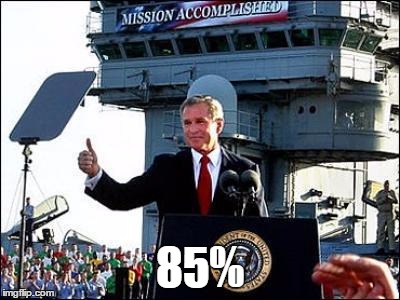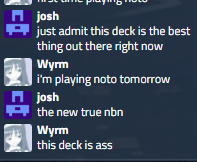Spark Despotism – King Beale on NRDB
This week on NRDBir, Stimhack league champion, and Ohio city grid streamer Josh01 volunteers as tribute to report on the front page.
| Spark Agency: Worldswide Reach | |
| Agenda (11) 1x 15 Minutes 3x Breaking News 3x Global Food Initiative ••• 3x Project Beale 1x TGTBTAsset (10) 1x Adonis Campaign •• 3x Jackson Howard 3x Launch Campaign 3x PAD CampaignUpgrade (5) 1x Ash 2X3ZB9CY •• 3x Product Placement 1x Red Herrings Operation (7) |
Barrier (3) 1x Wall of Static 2x Wraparound Code Gate (6) 1x Enigma Sentry (5) Other (2) |
| 15 influence spent (max 15) 20 agenda points (between 20 and 21) 49 cards (min 45) Cards up to Data and Destiny |
|
As the astute reader has already gathered, King Beale is a NBN glacier deck without AstroScript Pilot Program. It’s been all the rage lately to play decks with less AstroScripts, ever since Damon Stone produced a list of the ten best cards in the game and Prepaid VoicePAD, stipulating that playing them will limit the deckbuilding privilege to include other cards out of faction.
So by force, even the most cold hearted, risk averse, scientific, game theory oriented of us have opened up to new IDs and styles. By popular choice, we ended up here, with NEH’s son Spark, who has the legacy of all the good NBN ideas packed into a shell with none of the speed or influence of his father. Whenever anyone makes an NBN deck, it’s difficult to measure up to the other NBN deck yours will inevitably be compared to and almost certainly fall short of, but by some stroke of luck, thanks to our lord Damon Stone, we may note the pedigree of Spark without having to compare it to its predecessor, who is currently going through a midlife crisis.
Like the ID carries its pedigree, the list and description is also a full nerdbear thoroughbred with all the qualities of a NRDB front-pager.
Heavy handed personification of the deck as a monster: Check.
Ominous shot of 1984 at the top: Check.
“This deck is hard to pilot” caveat: Check.
At least one popular card in every deck ommitted: Check.
Archer: Check.
It’s not as if AstroScript was left off haphazardly; the author goes out of his way to write about his choice to not include the restricted behemoth. Infact, he spends about 20% of the deck’s description pre-emptively defending the decision, almost like it was a deckbuilding goal. For performance credit, he notes he took 6th and a 32 player event and is sporting an 85% winrate on Jinteki.net.
I know what you’re thinking: “Jinteki.net? The quality of practice is so variable between playing your friends, random strangers on 90 card decks, and the best players in the world. How can we use Jnet as a relevant benchmark of a deck’s performance?”
While I’m inclined to agree with you, I’ll note that Minh Tran recently posted the stats of players up to December 31 on Stimhack. On the Corp side, almost nobody is batting .850. I don’t know the author’s Jnet handle, but even King Beale himself may be taking some creative liberties with his statkeeping, caught up in the story of the deck. Speaking of which, I’d be remiss not to note the careful storytelling of the author given the bold pretext and fittingly creepy screenshot looming overhead. He compares the deck to Despotism, citing the tag punishment and program destruction as means of oppressing the runner.
Initially, it’s easy to identify a few potential flaws. The deck has 16 ICE, 14 if you count Special Offer as a Hedge Fund, and 11 agendas. Three of the agendas are impossible to score against a deck that can camp the remote, because there is only one Ash (one of the only two cards a glacier deck can use to score in the modern meta). If you never draw Ash, you are resigned to trashing their programs or losing the game. If the Runner finds a long term solution to Archer (femme, parasite, shutdown, etc.) and never does anything other than gain money and camp your remote, it would seem as if you cannot win. The deck includes a Red Herrings, which I would prefer to leave in the binder. There’s a bit of tag punishment, but nowhere near enough to warrant either Midseason Replacements or Data Raven. Only 8 of the ICE end the run, and half of them are easily dealt with. All of the sentries are beaten by alternative Killer solutions; none of them gear check Mimic. Cyberdex Virus Suite is nowhere to be found, despite the win condition of the deck being related to trapping the runner on an Archer or an Ichi. Oh, and instead of AstroScript Pilot Program, there is a TGTBT.
I played King Beale on Jinteki.net for a total of 20 games (the minimum number of games needed to obtain a 85% win rate). I won eighteen of the games, boasting a 90% winrate against the Jnet field.

This was an adequate sample size to learn how the deck operates, what its good and bad matchups are, and whether the initial criticism holds any merit. The games were of varying speeds, the ICE was hit or miss, and the ID triggers were painful on both ends (having Jnetters make up timing rules that benefit them forced me to bookmark the timing structure of a corp turn image).
Whenever you include cards with wildly situational use, you introduce another factor into the game that is exploitable by an experienced player. The difference between Archer firing all four subs or being carefully played around is massive, especially given that the cost is an agenda. Scoring 5/3s in servers without Ash that can be contested by an experienced player but will largely go uncontested by players more interested in installing an eleventh connection onto The Supplier is not only a five point agenda swing, but can also be a considerable click and credit investment wasted by the Corp. The power of Midseason Replacements, Closed Accounts, Breaking News (when used for value), or any tag punishment is dependent on the Runner’s vulnerability to it, which is never more self-imposed than against King Beale.
There have been countless successful decks built on strategies otherwise considered gimmicks that force the Runner to make compromised decisions resulting in unavoidable losses. Butcher Shop is a deck able to leverage Midseasons with the immediate threat of an on-board Breaking News resulting in a flatline. The number of potential outs to victory increase with synergistic tools like AstroScript Pilot Program or SanSan City Grid. Fast advance decks are able to force the Runner to make suboptimal runs and asset trashes to reduce the chance of the Corporation drawing or holding important agendas or tools on the back of Astro counters and Biotics. Supermodernism has often placed the Runner in a compromised position using program trashing as a strategy by ensuring it has plentiful ICE that gear checks the Runner and tools like Cyberdex Virus Suite or Corporate Troubleshooter to prevent the Runner from easily playing around it.
Without 24/7, Scorched Earth, AstroScript Pilot Program, agenda-scoring tools (Ash, Caprice), or fast advance tools (SanSan City Grid, Psychographics), King Beale gives the illusion of being a balanced midrange deck capable of devastating a Runner’s boardstate in a variety of ways without committing enough to any of them to be effective against a reasonably competent player on a well constructed deck. Closed Accounts on more than a couple occasions drained Runners of copious amounts of credits, but only because they stockpiled them needlessly in situations where they could be hit with a Breaking News for value, ran and accessed TGTBT last click, floated tags, gave Data Raven a counter, etc. There were countless moments where I’d pray a CVS found its way into the deck so I could get an on-approach blowout with Archer or Ichi, but usually playing around them was as simple as understanding how many Datasucker counters are necessary to reduce an ICE’s strength to three. On multiple occasions I could have closed the game out if a scored Beale was an Astro, or if my TGTBT was worth anything other than holding and hoping the Runner hit on their last click.
I was able to score multiple three point Beales, and even a four point Beale, but it never felt considerably better than scoring an Astro and dropping another agenda (two Astros are often worth the same as an eight point Beale). TGTBT was effective when Runners ran into it haphazardly, but often sat in HQ or Archives, waiting to be moved. I think I landed Midseasons a grand total of one time. Red Herrings was great against Runners who didn’t plan to access a remote with an advanced card and upgrade with five or more credits, and awful when they came in expecting an Ash (even worse when trashed out of R&D). The majority of my wins felt like games that should have been lost against an opponent who kept me honest, and my two losses were hopeless cases despite opening into a decent enough hand.
14 ICE discounting Special Offer is not enough for a midrange deck, especially when Launch Campaigns, Adonis, and eleven agendas all often need to be simultaneously protected. Data Raven was often too expensive to warrant its limited effect on the Runner, Ichi was lacking without the threat of a CVS blowout, Wall of Static was for most purposes a dead draw, and Mimic was rarely gear checked.
A single Adonis proved to be effective at triggering Spark, and exactly the right number (you don’t want the remote cluttered with campaigns when each of your draws has a 22% chance to be an agenda). Pop-up Window and Product Placement are efficient and often a timely surprise to the Runner. PAD is good at leveraging the Runner’s ability and willingness to spend money to play small ball, as the ID is able to leverage it for another credit. Hedge Fund never seemed to be missed, and Sweeps Week may actually be of more use.
Ultimately, King Beale is another cautionary tale in trying to do too much and succeeding to do nothing as well as anyone is already doing it. Spark revolves around advertising, but King Beale isn’t a rousing endorsement of new age post-MWL decks. It’s a Ritalin commercial. It’s not Despotism. It’s Anocracy. The only one forced to fit things where they don’t belong and make compromised, sub-optimal decisions is the Corp, forced to use half measures to leverage its strengths where other yellow decks are making full use of their card pool, which has no shortage of powerful cards.
You can win a lot of games with this deck. By the author’s own account, you can win 85% on Jinteki.net, and by mine you can win a little more. If you put this deck in front of a good player on a good deck, though, you can’t expect a satisfactory winrate in the slightest. I’d estimate something in the neighborhood of 25%.
There’s good news, though. You can swap just a couple cards to make the deck a lot more effective. More Ash instead of multiple Archers or the Archived Memories will help. Removing Red Herrings in favor of one, two, or even three Cyberdex Virus Suite is a good trade. More ICE will help smooth out some consistency issues. Turnpike and Resistor are good options that force a gear check at a better price than some of the other ICE. And before I forget about the most salient point, some of you are still patiently waiting for an answer.
“Is King Beale better without AstroScript Pilot Program?”
No. No, it is not.


You should put Astroscript in there as well as your other changes, play another 20 games and if you get the same win rate +/- 5% it would be pretty difficult to argue the deck is worse for having Astroscript in it.
LikeLike
I really don’t think that the strength of Astroscript needs testing at this point.
LikeLike